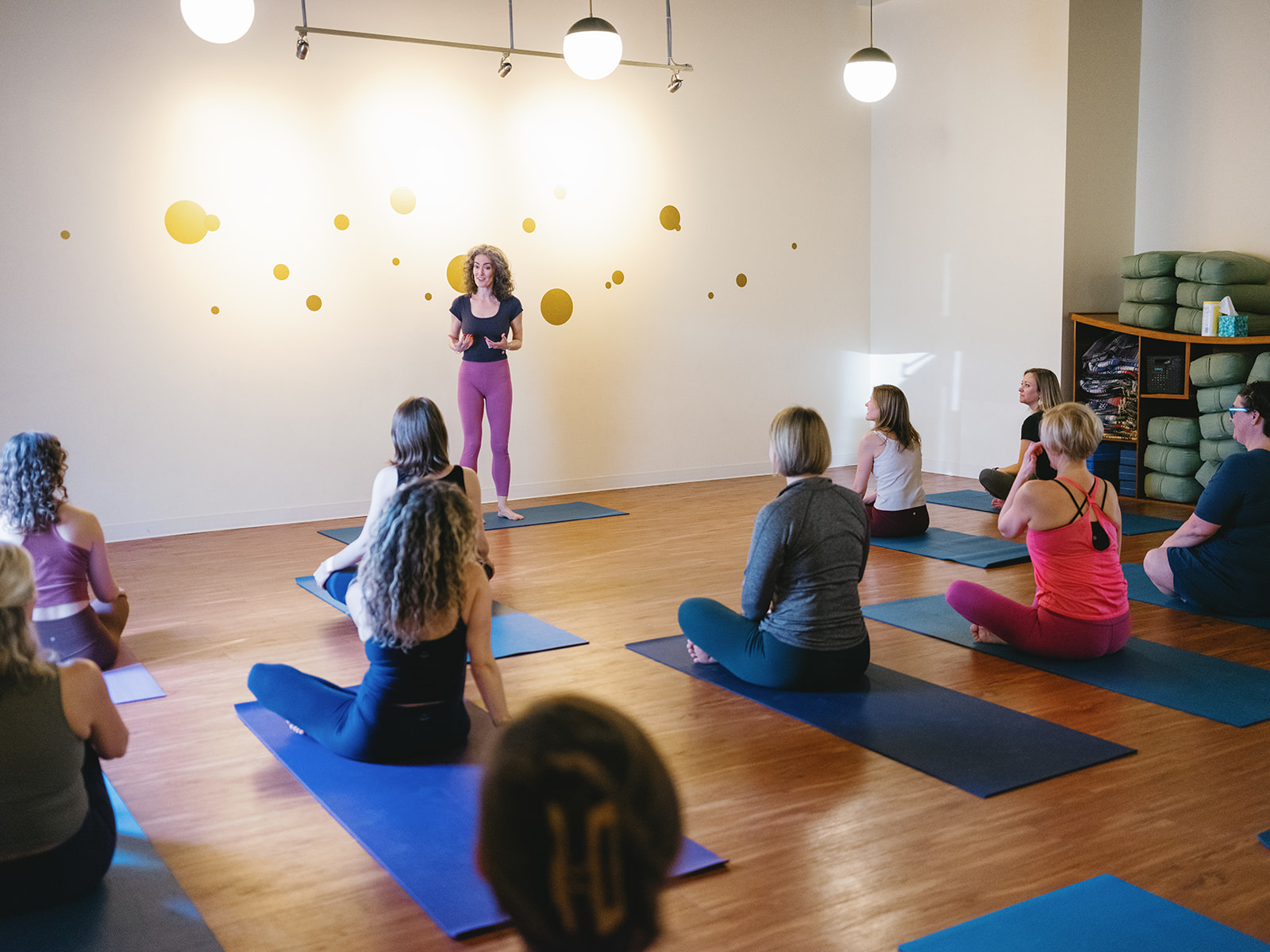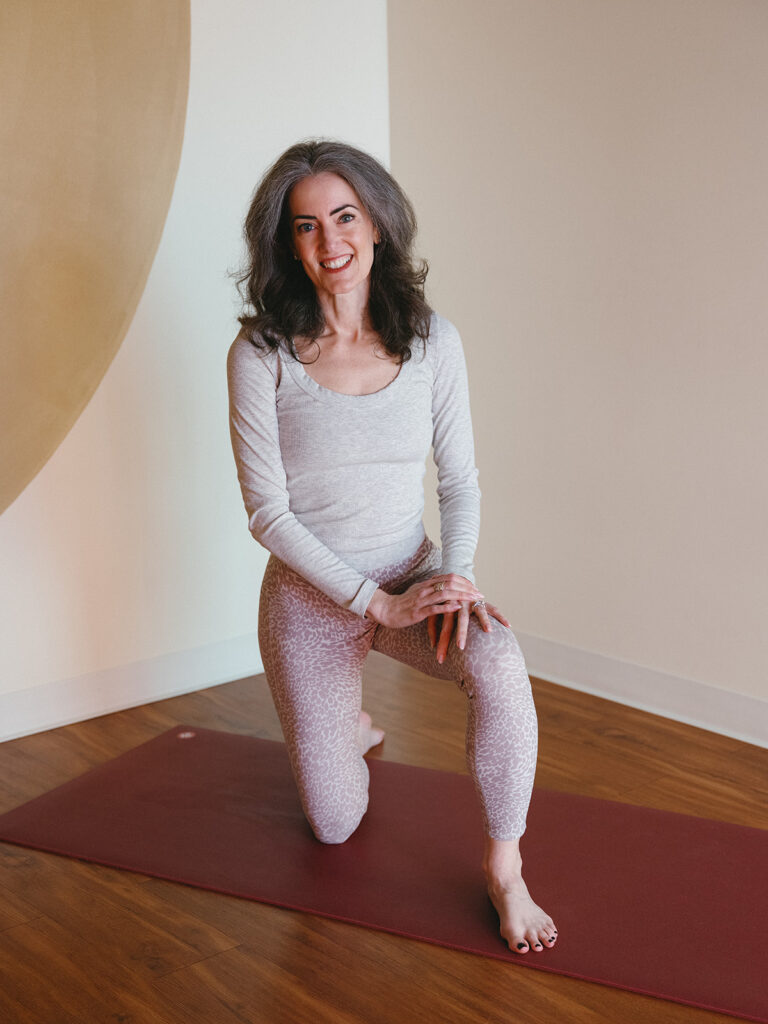The most common question I hear from yoga teachers isn’t about advanced poses or spiritual philosophy. It’s much more practical: “How do I plan classes without spending hours overthinking every detail?”
After two decades of teaching, mentoring hundreds of yoga teachers, and hearing this question in virtually every teacher training I lead, I’ve developed a framework that addresses this universal struggle. Today, I’m sharing it with you.
The Planning Confidence Cycle
Let me guess how your class planning typically goes:
You sit down to plan a class, staring at a blank page. You either:
- Spend WAY too much time crafting the “perfect” sequence, only to doubt it entirely before you teach
- Fall back on the same sequence you always teach (hello, Warrior 2-reverse Warrior-extended side angle loop!)
- Decide to “see what the room needs” and wing it completely
Sound familiar? I’ve been there, too.
What I’ve observed is that most yoga teachers are caught in what I call the Planning Confidence Cycle—the more uncertain you feel about your class structure, the more time you spend planning, which leaves less time for actually connecting with the practice, which further diminishes your confidence.
It’s exhausting, unsustainable, and completely unnecessary.
Introducing the S.E.R.V.E. Method
After years of helping teachers find the right balance between structure and creativity, consistency and variety, I’ve distilled my approach into what I call the S.E.R.V.E. Method:
- Structure Your Foundation
- Experience Before Teaching
- Repeat with Purpose
- Vary with Intention
- Evolve Your Voice
This isn’t another “follow my exact sequence” approach, nor is it a vague “just follow your intuition” non-system. It’s a practical framework that gives you both solid ground to stand on AND room to grow into your unique teaching style.
Let’s break it down.
S: Structure Your Foundation
Every effective yoga class needs a physiologically sound foundation. This is where my 6-4-2 framework comes in (if you’re not familiar with it, I explore it fully in my book The Art of Yoga Sequencing).
In brief, a balanced yoga practice includes:
- Six movements of the spine
- Four lines of the legs
- Two core actions
When you start with this structure, you ensure your class gives students a comprehensive movement experience, regardless of the specific poses you choose.
Try This: Before finalizing any class plan, use a simple checklist to verify you’ve included all key movement patterns. You might even color-code your sequence notes (blue for forward bends, red for backbends, etc.) to quickly visualize balance.
E: Experience Before Teaching
Here’s a truth many teachers miss: if you haven’t felt a sequence in your own body, you’ll struggle to guide it confidently for others.
Before teaching any sequence—even one you’ve created yourself—practice it. Notice where transitions feel awkward, where the intensity builds too quickly, or where you need more preparatory poses.
When you’ve experienced your sequence firsthand, you’ll teach from embodied knowledge rather than theoretical concepts.
Try This: Record yourself verbally walking through your sequence, then practice with your own guidance. Note any moments of confusion, imbalance, or transition challenges. This simple practice can transform how you teach.
R: Repeat with Purpose
Here’s a radical idea in the yoga world: you don’t need a brand new sequence for every class you teach.
In fact, thoughtful repetition benefits both you and your students. For you, it reduces planning time and allows you to refine your teaching. For your students, it creates familiarity that helps them go deeper into the practice rather than constantly figuring out what comes next.
The key is purposeful repetition with minor variations to keep the practice fresh.
Try This: Create a monthly lesson plan with weekly variations—same basic structure, different emphasis each week. Think of this like layering accessories over a capsule wardrobe. The constituent parts remain the same; the flair changes up slightly.
V: Vary with Intention
While repetition creates a foundation, thoughtful variation keeps your teaching vibrant. The crucial distinction is varying with clear intention rather than changing things randomly in pursuit of “creativity.”
Effective variations respond to student needs, energy levels, seasonal considerations, or specific focal points—not to your anxiety about keeping things “interesting enough.”
Try This: Create a “variation bank” for each part of your class structure with options for different energy levels, experience levels, and physical needs. When you decide to introduce a variation, you’ll do so from a place of purpose rather than pressure.
E: Evolve Your Voice
Your teaching voice—like your physical voice—is uniquely yours. It will naturally evolve over time as you gain experience and confidence.
The S.E.R.V.E. Method isn’t about conforming to someone else’s teaching style; it’s about giving you a reliable foundation so you can find and refine your authentic approach.
As you become more comfortable with structure, experience, repetition, and intentional variation, you’ll naturally begin integrating your unique perspective, experiences, and insights into your teaching.
Try This: After each class, note one moment where you felt most authentically connected to your teaching and one opportunity to infuse more of your unique perspective next time.
Breaking Free from Planning Anxiety
What I love most about this method is how it addresses the root cause of planning anxiety: the false belief that you must choose between structure and creativity, between consistency and variety.
The S.E.R.V.E. Method recognizes that these apparent opposites actually complement and strengthen each other. Structure enables creativity. Consistency creates space for meaningful variation. Experience builds confidence. It’s sthira and sukha uniting—it’s yoga.
When you embrace this approach, you’ll find yourself spending less time planning and more time connecting: with your practice, with your students, and with your authentic teaching voice.
Your Next Step
If the Planning Confidence Cycle sounds all too familiar, I invite you to try just one component of the S.E.R.V.E. Method this week. Perhaps start with the Structure checklist or the Experience practice.
Notice how even this small shift might reduce your planning anxiety and increase your teaching confidence.
And if you’re ready to fully implement this framework with personalized guidance, join my Mastering the Art of Yoga Sequencing mentorship program, where we’ll explore each component of the S.E.R.V.E. Method in depth. This program is especially rich in the first E, as you’ll get to follow along with full-length lesson plans on demand to reignite your studentship, which in turn makes you a far better teacher.
Because here’s what I know for sure after twenty years of teaching: when you free yourself from planning anxiety, you create space for the real magic of yoga teaching to emerge—authentic connection, transformative experiences, and the unique gifts that only you can offer your students.
Want to dive deeper into the S.E.R.V.E. Method? Join me for a free workshop June 24, 2025, where I’ll walk you through each component with practical exercises you can implement immediately. It’s in Comfort Zone Yoga, my free community for yoga teachers—sign up below!


